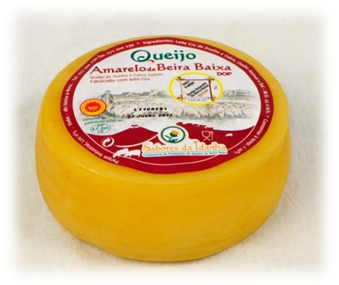Description: The Queijos da Beira Baixa PDO includes the follow cheeses:
Queijo de Castelo Branco – is made with raw sheep’s milk. Is a mature cheese, with semi hard or semi soft paste and yellowish colour.
Queijo Amarelo da Beira Baixa – is made with raw sheep’s milk or with sheep’s and goat’s milk. Is a mature cheese, with semi hard or semi soft paste and yellowish colour.
Queijo Picante da Beira Baixa – is made with raw sheep’s milk and goat’s milk. Is a mature cheese, with semi hard to hard paste and grayish white colour.
Production method: The manufacturing methods of Queijos da Beira Baixa PDO depends the type of the desired cheese, namely:
Queijo de Castelo Branco – it’s used a natural rennet (Cynara Cardunculus) and the maturation process are made with 8 to 14 °C of temperature and 80-90% of relative humidity, during, at least, 45 days. Regarding “Queijo de Castelo Branco Velho” the process during, at least, 90 days.
Queijo Picante da Beira Baixa – it’s used the animal rennet and the maturation process makes with 10 to 18 ºC of temperature and 70 to 80%, during 120 days.
Queijo Amarelo da Beira Baixa – the rennet used is from animal source and the maturation process is between 10 to 18 °C and relative humidity of 70 to 85%, during 45 days. Like Queijo de Castelo Branco its maturations can be extended untill 90 days (in minimum), turning a mature with hard to extra-hard paste, usually called “Queijo Amarelo da Beira Baixa Velho”.
Distinctive features: The distinctive features of Queijos da Beira Baixa PDO are due the flocks of sheep are kept out in the fields in the open air all the year round. They having access to different pastures, some of which is specifically planted.
Regarding to the products, they have the follow characteristics:
Queijo de Castelo Branco – Has a diameter of 12 to 16 cm and weight between 800 to 1300 g. The taste and aroma are intense and a little spicy for “Queijo de Castelo Branco Velho”.
Queijo Picante da Beira Baixa – Has a diameter between 10 to 15 cm and weight between 400 to 1000 g. The aroma is intense and typical and the taste is strongly spicy.
Queijo Amarelo da Beira Baixa – Has a diameter between 7 to 10 cm and weight between 200 to 500 g. The aroma is intense and pleasant, however, the taste is clean and a slightly acidified.
Production area: Queijos da Beira Baixa PDO cheeses are made in the municipal areas in the district of Castelo Branco and part of the Santarém district.
History: The manufacturing of Queijos da Beira Baixa PDO began in 1870, in Castelo Branco Region, being Lisbon its main market.
Previously, the ovines were only been kept for their wool.
In 1905 the professor Joaquim Rasteiro refers the Queijo de Castelo Branco as one of the oldest and popular cheeses. And, in 1940, under a program to encourage the study of Portuguese cheeses, begins the depth study of the Queijos da Beira Baixa chesses.
Product specifications (pdf)
Producer group
APQDCB - Associação dos Produtores de Queijo do Distrito de Castelo Branco
Control and certification body
BEIRA TRADIÇÃO - Certificação de Produtos da Beira, Lda
Control plan
Control plan (pdf)
Publication in EU official journal
Reg. (CE) n.º 1107/96 - L148 21.06.1996
JOUE C 315 23.09.2020
Reg. (UE) 2021/245- L 57/80 18.2.2021
Publication in the Portuguese official journal
Despacho n.º 9634/2016, de 27 de julho
Aviso n.º 4052/2016, de 24 de março
Despacho n.º 10518/2007, de 04.06.2007
Aviso n.º 4316/2005, de 30 de março
Despacho (2ª série), de 26.01.1990



